Anti-ship missile systems. Part two. In the air
In this article we will continue the story about domestic anti-ship missile systems and their foreign counterparts. The talk is about air-based SCRC. So let's get started.
German Hs293 and domestic "Pike"
The basis for the creation of the anti-ship missile "Pike" was taken by the German Henschel missile, Hs293. Her tests in 1940 showed that the planning version was worthless, since the rocket lagged behind its carrier. Therefore, the rocket was equipped with a liquid rocket engine, providing the necessary acceleration in 10 seconds. About 85% of the way the rocket flew by inertia, so the Hs293 was often called the "missile gliding bomb", while in Soviet documents the name "reactive aviation torpedo".
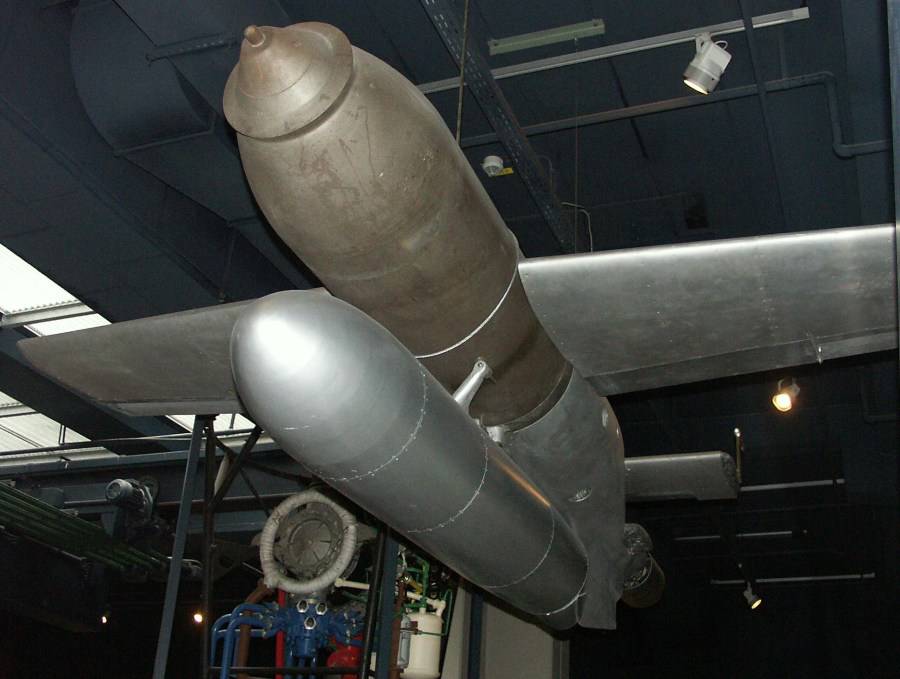
By the right of the winner of the USSR, he received numerous samples of military equipment and relevant documents from Germany. It was originally planned to establish its own release Hs293. However, 1948 tests of the year showed a negligible accuracy of hitting missiles with our carriers and the Pechora radio command. Only 3 of 24 fired missiles hit the mark. More talk about the release of Hs293 did not go.
In the same year, 1948 began the development of the PAMT-1400 “Pike” or, as it was also called, “reactive aviation sea torpedoes”.

Hs293 was distinguished by poor maneuverability, in order to avoid this, on the “Pike” they installed spoilers on the rear edges of the wing and tail, they worked in relay mode, making continuous oscillations, the control was carried out by different time deviations from the main position. It was planned to place in front of the radar sight. The radar image was transmitted to the aircraft carrier, in accordance with the received image, the crew member produces control commands, transmitting them to the rocket via radio. This guidance system was supposed to provide high accuracy regardless of weather and launch range. The warhead remained completely unchanged, completely taken from Hs293, the conical warhead allows you to hit ships in the underwater part of the board.
It was decided to develop two versions of the torpedo - "Pike-A" with a radio command system and "Pike-B" with a radar sight.
In the fall of 1951, the KRU-Pike radio equipment tested the rocket, and after several failures, performance was achieved. In the 1952, there were launches from the Tu-2, the first fifteen launches showed that the probability of hitting a target from a height of 2000-5000 m at a distance of 12-30 km is equal to 0,65, approximately ¼ of the hits fell into the underwater part of the board. The results are not bad, however, the Tu-2 was removed from service.
The rocket was changed for use with the IL-28. With 14 launches from IL-28 at a distance of up to 30 km, the probability of hitting the target dropped to 0,51, while the underwater part of the board was hit only in one of five hits. In the 1954 year, the Pike-A entered mass production, the X-NUMX Il-12 machines were converted to equip with these missiles.
The version of the Shchuka-B rocket was more like the original design, in the nose part behind the fairing there was the guidance equipment, under it - the warhead. It was necessary to further refine the GOS and LRE, the hull was shortened to 0,7 m. The launch range was 30 km. In tests that took place in the spring-summer of 1955, none of the six missiles reached the target. At the end of the year, three successful launches were made, however, work with the Aviation "Pikes" ceased, and the release of IL-28 was turned off. In February, 1956 was no longer adopted by the Pike-A, and the development of the Pike-B was stopped.
KS-1 "Comet" and the complex Tu-16KS
The decree on the creation of anti-ship projectiles "Kometa" with a range of 100 km was issued in September 1947 of the year. For the development of missiles was created by the Special Bureau number 1. For the first time such a large amount of research and testing was planned.
The tests of the Comet took place from the middle of 1952 to the beginning of 1953 of the year, the results were excellent, in some parameters even exceeded the specified ones. The 1953 rocket system was adopted, and its creators received the Stalin Prize.
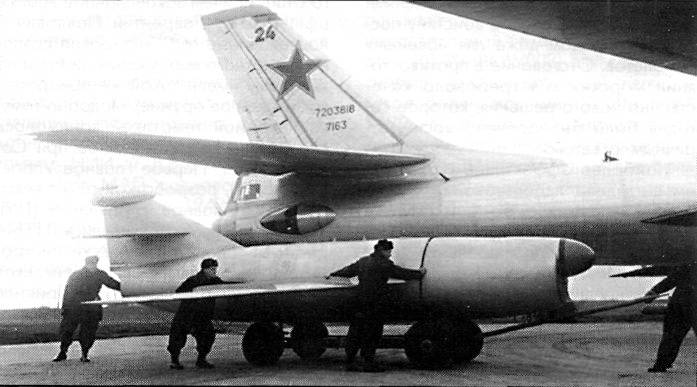
Continuing work on the Kometa system led to the creation of the Tu-16X aviation missile system. The Tu-16 installed the same guidance equipment that was used on the Tu-4, which was equipped with missiles earlier, placed the DB-187 girder holders and the rocket fuel system on the wing, and placed the missile guidance operator's cabin. The range of the Tu-16X equipped with two missiles was 3135-3560 km. The flight altitude was brought to 7000 m, and the speed to 370-420 km / h. At a distance of 140-180 km, the RSL detected a target, the rocket was launched, when the target remained 70-90 km, and later the launch range was increased to 130 km. The tests of the complex were carried out in the 1954 year, and he entered service in 1955. As of the end of the 1950-s, the five mine-torpedo regiments consisted of X-NUMX complexes Tu-90X. Subsequent refinements made it possible to launch two missiles from one carrier at once, and then three missiles were guided simultaneously with a launch interval of 16-15 seconds.
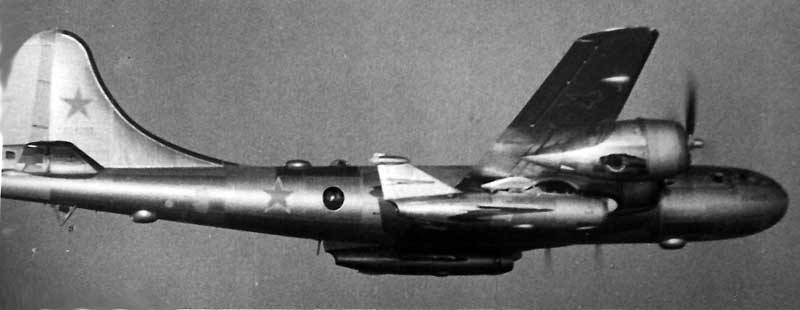
High-altitude launches led to the fact that the plane went out of attack close to the target, risking to get hit by an air defense. The low-altitude start-up increased the suddenness and hidden access to the attack. The probability of hitting a target was large enough, when it was launched from a height in 2000, it was equal to 2 / 3.
In 1961, the complex was supplemented with noise-resistant hardware units, which increased security from EW facilities, as well as reduced sensitivity to interference caused by the radar of their aircraft. Good results were obtained as a result of testing the group attack of the rocket carriers.
The successful Kometa missile system was in service until the end of the 1960s. Tu-16Xs did not participate in actual hostilities, some of them were subsequently sold to Indonesia and the UAR.
KSR-5 cruise missile in the K-26 complex and its modifications
A later development of an air-launched cruise missile was the KSR-5 as part of the K-26 complex. The western name is AS-6 "Kingfish". Its purpose is to defeat surface ships and ground targets, such as bridges, dams or power plants. The Ordinance on the creation of KSR-5 missiles equipped with the Vzlyot control system in 1962 in the year set the launch range of 180-240 km, with a flight speed equal to 3200 km / h and an altitude of 22500 m.
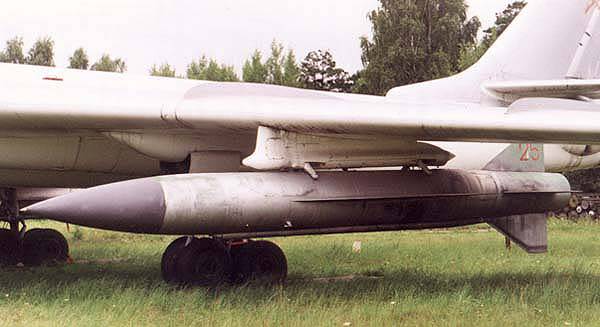
The first stage of the test (1964-66 of the year) was considered unsatisfactory, low accuracy was associated with deficiencies in the control system. Tests after the completion of improvements with the Tu-16K-26 and Tu-16K-10-26 aircraft were carried out until the end of November 1968. The speed of launch vehicles was 400-850 km / h, and the altitude 500-11000 m. The launch mode was significantly influenced by the flight mode according to the operating conditions of the radar and homing missiles. At the maximum height, the target was captured at a distance of 300 km, and at a height of 500 m - no higher than 40 km. Until the spring of next year, experiments continued, as a result of which the K-12 and K-26-10 aviation missile complexes were adopted on November 26.
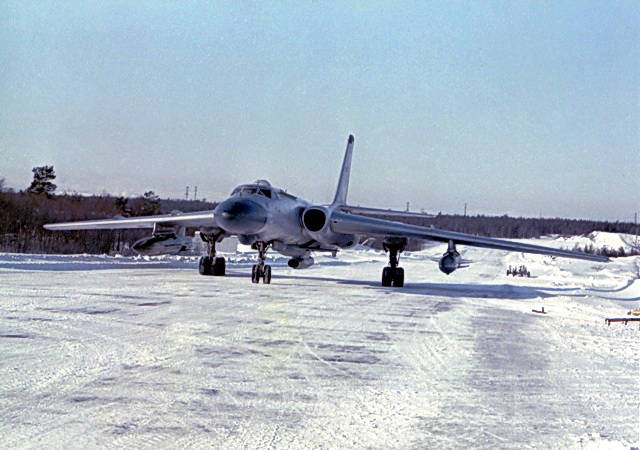
The new upgraded version of the KSR-5М rocket, on the basis of which the K-26M complex was created, is designed to combat small-sized, complex targets. The K-26H complex, equipped with the KSR-5H missiles, possesses the best accuracy characteristics and operates at low altitudes, it was necessary to modernize the search and targeting system. On the 14 aircraft, a panoramic Berkut radar was installed with an increased radome from the IL-38 aircraft.
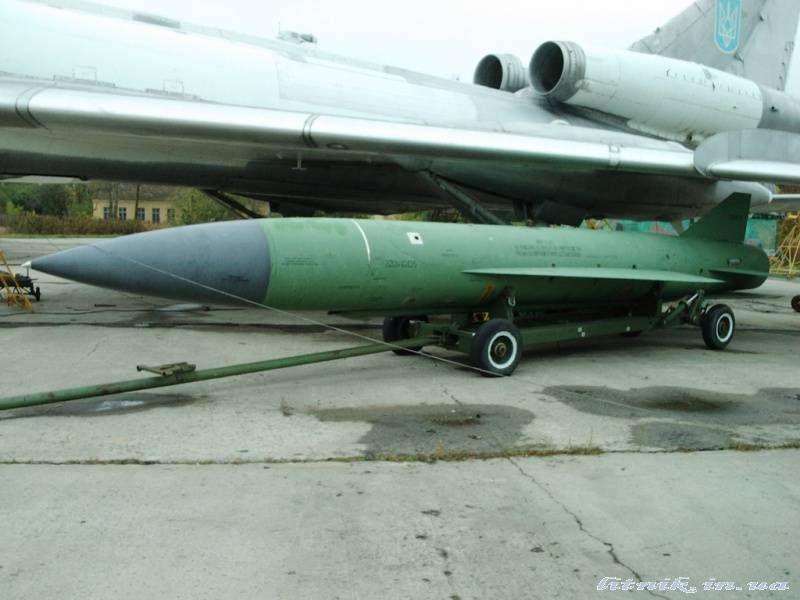
In 1973, the use of the Rubin-1M radar, characterized by a greater detection range and better resolution with a large-sized antenna system, respectively, the gain increased and the width of the radiation pattern decreased by one and a half. Target detection range at sea reached 450 km, and the size of the new equipment required to move the radar to the cargo compartment. The nose of the cars became smooth, since they no longer had the same radar. The weight decreased due to the rejection of the bow gun mount, and the tank number XXUMX had to be removed to accommodate the equipment units.
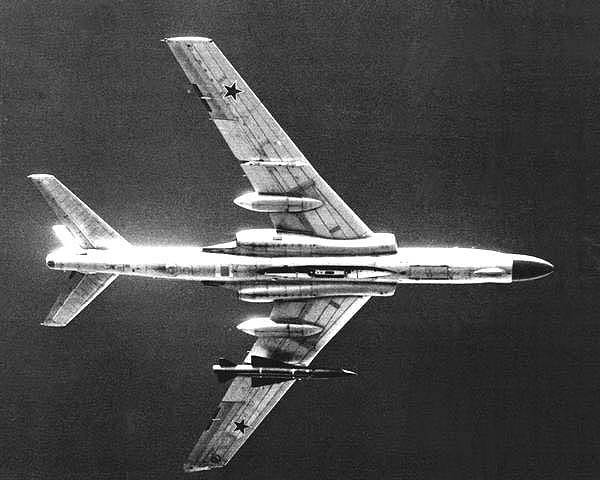
In 1964, it was decided to start the development of the K-26P complex with KSR-5P missiles, which were equipped with passive GPS. The search for targets was carried out using an airborne radar reconnaissance and target designation station “Ritsa” in conjunction with electronic reconnaissance equipment. After successful state tests, the K-26P complex was adopted by naval aviation in the 1973 year. The complex was able to hit radio-emitting targets using single or twin rockets in one go, as well as attack two different targets - lying on the course of the flight and located in the 7,5 ° range from the axis of the aircraft. K-26P was upgraded after the appearance of the KSR-5M, K-26PM was distinguished by the use of improved target designation equipment for missile heads.
KSR-5 and its modifications have been put into mass production. The Tu-16А and Tu-16К-16 bombers reworked its carriers. The range of the missiles exceeded the capabilities of the carrier radar, so the potential of the missiles was not fully utilized, so Rubin radar with an antenna from the Berkut began to be installed on the carriers, so the target detection range increased to 400 km.
The Tu-16K10-26, which had two КСР-5 under the wing on girder holders in addition to the standard K-10C / SNB rocket, became the strongest aviation anti-ship complex in the 1970-year.
In the future, attempts were made to install the K-26 complex on the 3M and Tu-95M aircraft. However, the work was stopped because the issue of extending the life of the aircraft was not resolved.
Today, combat DAC-5, DAC-5H and DAC-P are removed from service. Right up to the beginning of the 1980-s, the K-26 missiles were practically indestructible by the available and promising anti-aircraft weapons.
Modern domestic anti-ship missile systems.
The 3M54E rocket, Alpha, was introduced to the public in 1993 at the arms exhibition in Abu Dhabi and at the first MAKS in Zhukovsky, a decade after the start of development. The rocket was originally created as a universal. Developed a whole family of guided missiles "Caliber" (export name - "Club"). Some of them are designed to be placed on strike aircraft. The basis was the strategic cruise missile "Granat", consisting of nuclear submarines of the project 971, 945, 667 AT, and others.
The aviation variant of the complex - “Kalibr-A” is intended for use in almost any meteorological conditions, at any time of the day to hit sedentary or stationary coastal targets and sea ships. There are three versions of the ZM-54AE - a three-stage cruise missile with a detachable supersonic combat stage, the 3М-54АЭ-1 - a two-stage subsonic cruise missile, and the ZM-14АЭ - a subsonic cruise missile that serves to destroy ground targets.
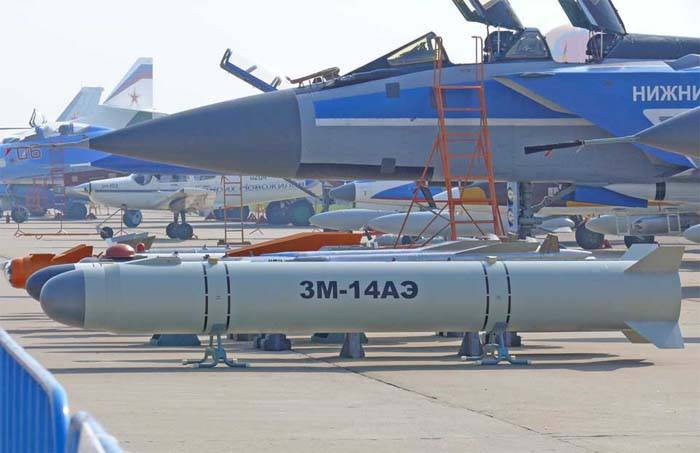
Most of the nodes of missiles are unified. Unlike sea-based and land-based missiles, aircraft missiles are not equipped with starting solid-fuel engines, cruise engines remain the same - modified turbofan engines. The onboard missile control system is based on the autonomous inertial navigation system AB-40E. For targeting at the end of the site meet the noise-free active radar homing. The radio-altimeter of the type RVE-B, ZM-14AE is additionally included in the control complex; it is additionally equipped with a satellite navigation system signal receiver. Combat units of all high-explosive missiles, both with contact VU and with non-contact ones.
The use of 3М-54АЭ and 3М-54АЭ-1 missiles is designed to defeat surface group and single targets in the conditions of electronic countermeasures in virtually any weather conditions. The flight of missiles is pre-programmed in accordance with the position of the target and the availability of air defense systems. Missiles can approach the target from a given direction, bypassing the islands and air defense, and are also able to overcome the enemy's air defense system at the expense of low altitudes and autonomy of guidance in the "silence" mode on the main flight segment.
For the ZM54E rocket, an active radar seeker ARGS-54E was created, which has a high degree of protection against interference and is capable of operating at sea waves up to 5-6 points, the maximum range is 60 km, weight is 40 kg, and length is 70 cm.
The ZM-54AE missile version of the missile cost did without the launch stage, the sustained stage is responsible for the flight on the main leg, and the combat one is for overcoming the air defense system of the target object at supersonic speed.
The two-stage ZM-54АE is smaller in size and mass than the ZM-54AE, the greater the effectiveness of the damage associated with the warhead of greater mass. The advantage of the ZM-54E can be called supersonic speed and extremely low altitude on the last leg (the combat stage is separated in 20 km and at 700-1000 m / s attacks at an altitude of 10-20 m).
High-precision cruise missiles ZM-14AE are designed to destroy ground control points of troops, weapons depots, fuel depots, ports and airfields. RVE-B type altimeter provides stealth flight over land, allowing you to accurately maintain altitude in the mode of rounding of the terrain. In addition, the rocket is equipped with a satellite navigation system of GLONASS or GPS types, as well as an active radar GPSH ARGS-14E.
It is reported that such missiles will be armed with carriers for export. Most likely, we are talking about the Su-35, MiG-35 and Su-27KUB airplanes. In 2006, it was announced that long-range Su-35BM, which are exported, would be armed with long-range Caliber-A missiles.
Foreign analogues of domestic SCRC
Maverick AGM-65F
Among foreign aircraft-based missiles, we can mention the American “Maverick” AGM-65F - a modification of the air-to-surface tactical missile “Maverick” AGM-65A. The missile is equipped with a thermal imaging homing head, is used against marine targets. Her GOS is optimally tuned to destroy the most vulnerable places of the ships. The rocket is launched from a distance of more than 9 km to the target. Such missiles are armed with A-7E aircraft (withdrawn from service) and F / A-18 naval aviation.
For all variants of the rocket is characterized by the same aerodynamic design and dual-mode solid-fuel TX-481 engine. The high-explosive fragmentation warhead is in a massive steel body and weighs 135 kg. Explosive blasting is carried out after the rocket pierces the hull of the ship due to the large weight, the time of deceleration depends on the chosen target.
American experts believe that the ideal conditions for the use of "Maverick" AGM-65F - this is daytime, visibility is not less than 20 km, while the sun should highlight the target and mask the attacking aircraft.
Attacking Eagle YJ-82 (C-802)
The Chinese “Attacking Eagle,” as they also call the C-802 rocket, is an improved version of the YJ-81 anti-ship missile (C-801A), also intended for aircraft armament. C-802 uses a turbojet engine, so the range has increased to 120 km, which is two times more than that of the prototype. There are also variants of the rocket, equipped with the GLONASS / GPS satellite navigation subsystem. The C-802 was first demonstrated in 1989. These missiles are equipped with FB-7 supersonic bombers, Q-5 fighter-bombers and advanced J-4 multipurpose fighter aircraft, which are under development by the Chinese companies Chengdu and Shenyang.
Missiles with an armor-piercing high-explosive warhead provide the probability of hitting the target 0,75, even under the condition of enhanced opposition from the enemy. Due to the low altitude of the flight, the jamming complex and the low ESR of the rocket, its interception is complicated.
Already, on the basis of C-802, a new anti-ship missile YJ-83 was created with a greater range (up to 200 km), a new control system and supersonic speed in the final leg of the flight.
Iran planned major purchases of this type of missile from China, but deliveries were made only partially, because China was forced to abandon deliveries under US pressure. Now missiles are in service in countries such as Algeria, Bangladesh, Indonesia, Iran, Pakistan, Thailand and Myanmar.
Ckr exocet
PKP Exocet was developed jointly by France, Germany and Great Britain with the aim of hitting surface ships at any time of the day, in any meteorological conditions, in the presence of intense interference and firing opposition of the enemy. Officially, development began in the 1968 year, and the first tests of the prototype in the 1973 year.
All variants of missiles were repeatedly upgraded. The Exocet AM-39 aircraft rocket is smaller than its ship counterparts and is equipped with an anti-icing system. Manufacturing a propulsion engine made of steel made it possible to reduce the dimensions, as well as apply more efficient fuel, respectively, increasing the firing range to 50 km when starting from 300 m and 70 km when starting from 10000 m. In this case, the minimum height of the start is only 50 m
The merits of Exocet RCC are confirmed by the fact that its various versions are in service in more than 18 countries of the world.
PKR Gabriel Mk3 A / S
The third generation of “Gabriel” missiles was created in Israel in 1985 - this is the ship version of the MH3 and the aviation one - MHZ A / S. The missiles are equipped with active radar homing, protected from interference with fast frequency tuning, which is capable of operating in the mode of homing to the ship’s station of active interference, which greatly reduces the effectiveness of the enemy’s air defense.
The “Gabriel” AHM A / S anti-ship missile system is used by the Sky Hawk A-4, C2 CXF, Fantom and Sea Scan F-4 airplanes. Rocket launch is possible at a height of 90-9000 m, speed on low altitudes should be 400-650 km / h, at high altitudes - 650-750 km / h. The missile launch range is equal to 80 km.
The rocket can be controlled in one of two modes. Offline mode is used when the carrier is an attack aircraft (fighter-bomber). The mode with the correction of the inertial navigation system is used when the carrier is an aircraft of the base patrol aviation, the radar of which can accompany several targets at a time.
Experts believe that the autonomous control mode increases the vulnerability of electronic warfare, as the enabled active GOS searches a large sector. The inertial system is corrected to reduce this risk. Then the carrier aircraft accompanies the target after the launch of the rocket, correcting its flight over the radio command line.
PKR Sea Eagle
In 1986, the United Kingdom is completing the development of an aviation anti-ship all-weather medium-range rocket Sea Eagle, the purpose of which is to defeat surface targets at a distance of up to 110 km. In the same year, rockets entered service in return for Martel missiles, which were used to arm Bukanir, Sea Harrier-Frs Mk51, Tornado-GR1, Jaguar-IM, Nimrod aircraft, as well as Sea King-Mk248 helicopters.
Today, Sea Eagle PKR is used in Great Britain, India and in several other countries.
As a sustainer engine, a compact single-shaft turbojet Microturbo TRI 60-1 is used, which is equipped with a three-stage compressor and an annular combustion chamber.
On the march, the missile is aimed at a target with an inertial system, and at the final segment, an active radar homing, which detects targets with EPR above 100 м2 at a distance of about 30km.
Warhead stuffed with explosive RDX-TNT. Punching the light armor of the ship, the rocket explodes, resulting in a powerful shock wave, which demolishes the bulkheads of the nearest compartments of the affected ship.
The minimum height required to launch a rocket is 30 m. The maximum height is completely dependent on the carrier.
Anti-ship missile systems on submarines? Read in the sequel.
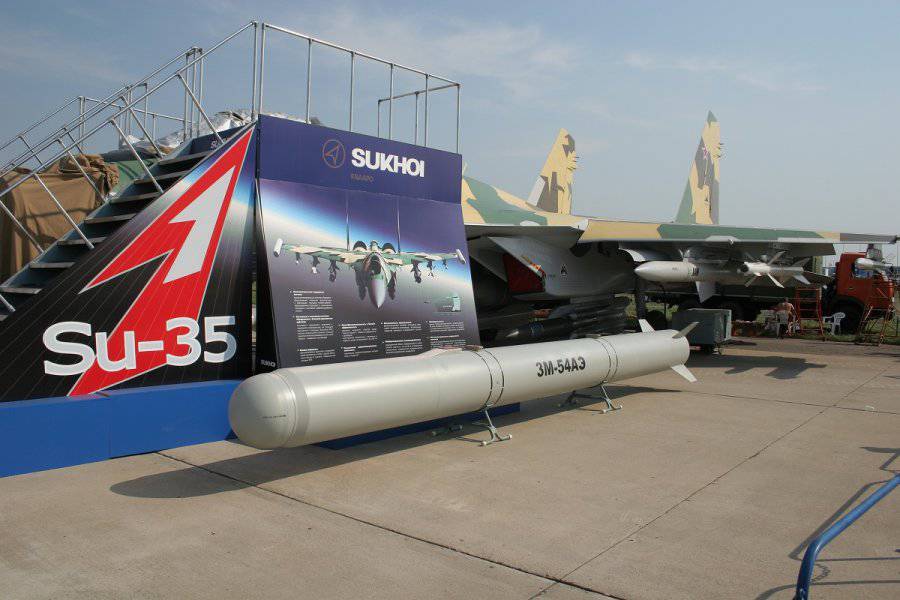
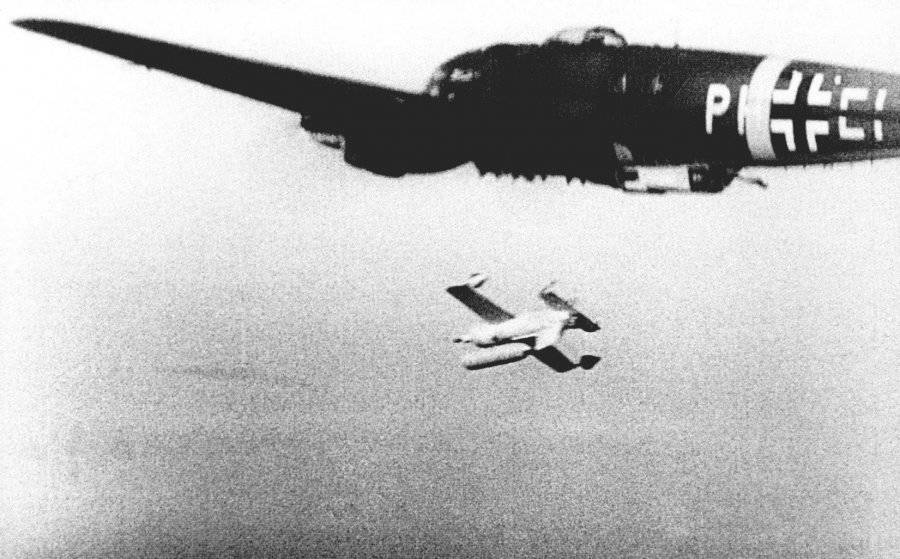
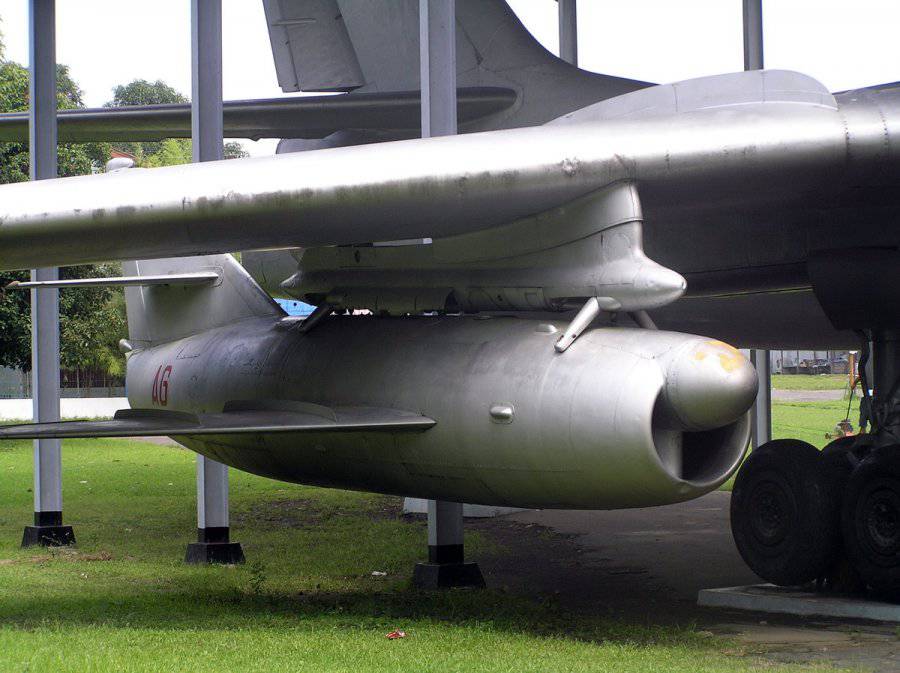
Information